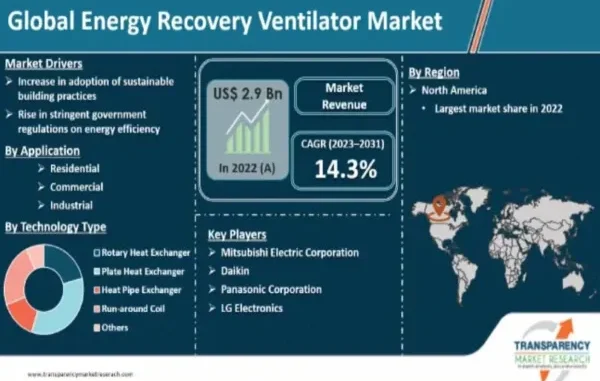
The heating, ventilating, and air conditioning (HVAC) sector is at a turning point brought about by the demand for sustainability. Residential and commercial customers are favoring systems that incorporate solutions for environmental responsibility as well as operating efficiency, according to a recent customer survey.
Extensive research provided by a market research consultant who is industry aware, along with in-depth consumer behavior analysis supports a space ready for a large upheaval. For the HVAC contractor, a comprehension of these trends is necessary if you want to maintain a competitive edge and take advantage of new opportunities in an environmentally-aware marketplace.
Growth of Sustainable HVAC Technologies
Sustainable HVAC is growing at a rapid pace, with an anticipated CAGR of more than 6%, from 2023 to 2030. Increasing energy prices and climate change make the demand high for effective, low-emission solutions.
Studies reveal that 73% of homeowners pay attention to energy ratings when purchasing HVAC appliances, while 58% are prepared to pay an additional 15–20% for a greener choice. Creating a major opportunity for providers of high-efficiency heat pumps, renewable integrations, and smart thermostats that will need to adapt to shifting consumer expectations.
Consumer Priorities: Sustainability as a Core Criterion
Today’s HVAC consumers, especially millennials and Gen Z, prioritize sustainability, with 82% of them saying that it is an important or very important factor influencing their purchasing decisions.
Preventative maintenance has increased 34% in three years as clients look for solutions that are both green and cost-effective. By providing a customized maintenance plan that enhance efficiency, improve the life of the equipment, and support their green credentials, providers can cash in.
Regulatory Frameworks Advancing Sustainability
With the need to combat climate change, global regulators are doubling down on their efforts to improve HVAC, a sector which provides one of the largest opportunities for emission reductions and energy savings. The Department of Energy in the United States has taken steps to enforce stricter efficiency standards in 2023, including new Seasonal Energy Efficiency Ratio (SEER) requirements. Similar regulations in Europe and Asia stress low-emission systems and low global warming potential (GWP) refrigerants.
Companies that take the lead in using low-impact refrigerants and energy-efficient technologies not only meet regulatory requirements but also secure an edge over their competition. Being an early adopter reduces the risk of expensive retrofits and improves the reputation as an industry leader in sustainability.
Smart Technology: Meeting Evolving Client Expectations
With the incorporation of smart technology, client expectations are changing in the HVAC sector. The smart HVAC market is forecasted to reach over $30 billion by 2028 and growing demand for systems that provide the capability to be remotely monitored and optimized. They want immediate control over their energy consumption, which naturally adds convenience and efficiency to their solutions.
Clients can now reduce waste and increase system lifespans via smart thermostats, predictive maintenance systems and energy management platforms. By utilizing these innovations, HVAC providers can offer flexible, environmentally-friendly solutions that appeal to the tech-savvy consumer and increased client retention and detraction in the market.
Retrofitting: A Strategic Approach to Sustainability
Retrofitting existing HVAC systems is a very low cost route to improving sustainability, and can also be an important change where infrastructure is older and has a lower overall build quality (and lifespan). Studies also show that up to 30% of the energy use in commercial facilities can be reduced with retrofitting, making it a solution that appeals to clients seeking environmental gains without fully replacing their systems.
This trend can produce further opportunity for HVAC service providers to develop a niche retrofitting business offering duct sealing, insulation improvements, and variable-speed motors. They allow clients to realize substantial savings in both energy and environmental impact, while ensuring that the providers of such interventions are seen as trusted partners in sustainable facility management.
Addressing Challenges in the Sustainable HVAC Market
This paradigm shift to sustainable HVAC is fraught with challenges. The relatively high upfront costs associated with green or eco-friendly systems, and a lack of technicians trained in advanced green technologies, limits the capacity for service delivery. However, these challenges also present opportunities for focused innovation.
Further recommendations from industry research include investing in technician training programs as well as developing clear pricing structures that can help gain the confidence of clients. By providing financing or energy-saving performance contracts, these cost barriers can be alleviated and sustainable solutions become more available. HVAC providers can differentiate themselves and capture the market share by tackling these challenges.
The Future of HVAC: A Commitment to Sustainability
The HVAC industry is undergoing a transformation driven by sustainability. Market trends and consumer behaviour clearly show that environmental responsibility is becoming central to long-term success. Providers that adopt energy-efficient technologies, adapt to evolving regulations, and meet client sustainability expectations will lead the way.






Leave a Reply